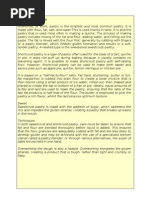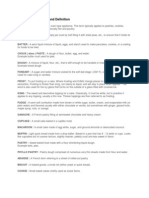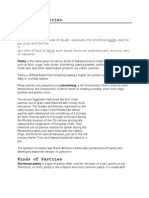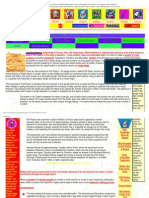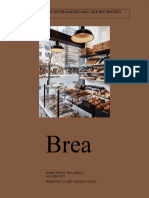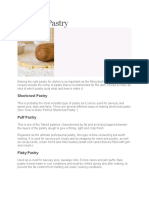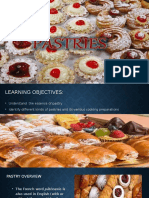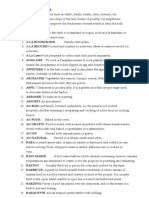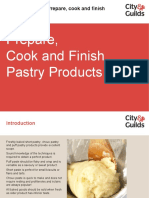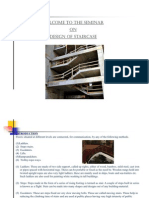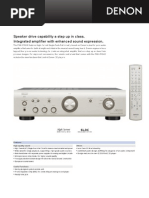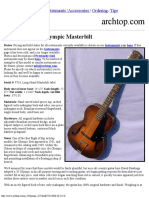0 ratings0% found this document useful (0 votes)
16 viewsMcgee 566
Mcgee 566
Uploaded by
ghj lkjjThis document summarizes waffles and wafers. It explains that waffles and wafers both involve spreading batter between heated, embossed metal plates which cook and imprint the batter. Waffles are usually thicker, lighter, and more delicate due to leavening, while wafers are thin, crisp, and dense if high in sugar. The document also summarizes choux pastry, used to make cream puffs and éclairs. Choux pastry involves cooking flour and water twice to create hollow, crisp pastries. An early French waffle recipe from 1651 is also included.
Copyright:
© All Rights Reserved
Available Formats
Download as PDF, TXT or read online from Scribd
Mcgee 566
Mcgee 566
Uploaded by
ghj lkjj0 ratings0% found this document useful (0 votes)
16 views1 pageThis document summarizes waffles and wafers. It explains that waffles and wafers both involve spreading batter between heated, embossed metal plates which cook and imprint the batter. Waffles are usually thicker, lighter, and more delicate due to leavening, while wafers are thin, crisp, and dense if high in sugar. The document also summarizes choux pastry, used to make cream puffs and éclairs. Choux pastry involves cooking flour and water twice to create hollow, crisp pastries. An early French waffle recipe from 1651 is also included.
Original Title
mcgee-566
Copyright
© © All Rights Reserved
Available Formats
PDF, TXT or read online from Scribd
Share this document
Did you find this document useful?
Is this content inappropriate?
This document summarizes waffles and wafers. It explains that waffles and wafers both involve spreading batter between heated, embossed metal plates which cook and imprint the batter. Waffles are usually thicker, lighter, and more delicate due to leavening, while wafers are thin, crisp, and dense if high in sugar. The document also summarizes choux pastry, used to make cream puffs and éclairs. Choux pastry involves cooking flour and water twice to create hollow, crisp pastries. An early French waffle recipe from 1651 is also included.
Copyright:
© All Rights Reserved
Available Formats
Download as PDF, TXT or read online from Scribd
Download as pdf or txt
0 ratings0% found this document useful (0 votes)
16 views1 pageMcgee 566
Mcgee 566
Uploaded by
ghj lkjjThis document summarizes waffles and wafers. It explains that waffles and wafers both involve spreading batter between heated, embossed metal plates which cook and imprint the batter. Waffles are usually thicker, lighter, and more delicate due to leavening, while wafers are thin, crisp, and dense if high in sugar. The document also summarizes choux pastry, used to make cream puffs and éclairs. Choux pastry involves cooking flour and water twice to create hollow, crisp pastries. An early French waffle recipe from 1651 is also included.
Copyright:
© All Rights Reserved
Available Formats
Download as PDF, TXT or read online from Scribd
Download as pdf or txt
You are on page 1of 1
552 cereal doughs and batters
Modern waffle recipes are often essen-
GRIDDLE CAKES:
tially a lean pancake batter cooked in a
WAFFLES AND WAFERS
waffle iron instead of on a griddle, and
Waffles and wafers have two things in com- they often produce a disappointing result
mon: the root word for their names, and that is more leathery than crisp. Crispness
the unique method by which they’re requires a high proportion of fat, sugar, or
cooked. Their flour-water mixture is spread both: otherwise the batter essentially steams
in a thin layer and pressed between two rather than fries, the flour proteins and
heated and embossed metal plates, which starch absorb too much softening water,
spread them even thinner, conduct heat and the surface ends up tough.
into them rapidly, and imprint them with
an attractive and often useful pattern. The
CREAM PUFF PASTRY,
usual square indentations increase the area
PÂTE À CHOUX
of crisp, browned surface and collect the
butter, syrup, and other enrichments that Choux is the French word for “cabbage,”
are often added on top. The French version, and choux pastry forms little irregular cab-
the gaufre, goes back to medieval times, bage-like balls that are hollow inside like
when street vendors would make them to popovers. Unlike popovers, choux pastry
order and serve them hot on religious feast becomes firm and crisp when baked. It pro-
days. vides the classic container for cream fillings
Today the difference between wafers in such pastries as cream puffs (profiteroles)
and waffles is a matter of texture. Wafers and éclairs, and also makes such savory
are thin, dry, crisp, and when high in sugar bites as cheese-flavored gougères and deep-
are dense, almost hard. The most familiar fried beignets, whose lightness inspired the
wafer is the ice cream cone; there are also name pets de nonne, “nun’s farts.”
French cookies called gaufres that are sim- Choux paste was apparently invented in
ilar to very thin, crisp tuiles. Waffles came late medieval times, and is prepared in a
to the United States from Holland in the very distinctive way. It’s a cross between a
18th century and are thicker, lighter, and batter and a dough, and is cooked twice:
more delicate thanks to leavening by either once to prepare the paste itself, and once to
yeast or a baking powder, which interrupts transform the paste into hollow puffs. A
the cooked structure with gas bubbles. large amount of water and some fat are
They’re served fresh and hot, their honey- brought to the boil in a pan, the flour is
comb structure filled with butter or syrup. added, and the mixture stirred and cooked
An Early French Waffle Recipe
Waffles of Milk or Cream
Put a litron [13 oz/375 g] of flour in a bowl, break in two or three eggs and mix together
while adding some cream or milk and a pinch of salt. Add a piece the size of two eggs
of freshly made cream cheese, or simply soft cheese from whole milk, and a quarteron
[4 oz/125 g] of melted butter. If you only add a half quarteron of butter, that is
enough provided that you add a half quarteron of good beef marrow crushed very small.
Mix all this together, and when it is well bound, one should put the waffle irons on
the fire, and make the waffles. These waffles should be eaten while they’re hot.
—La Varenne, Le Cuisinier françois, 1651
You might also like
- Heinemann MusicDocument12 pagesHeinemann MusicNettieNo ratings yet
- Baking Pastry VocabularyDocument7 pagesBaking Pastry VocabularyLaura FiorellaNo ratings yet
- Custard, Pudddings, Mousses & SoufflesDocument6 pagesCustard, Pudddings, Mousses & SoufflesSubrata Routh100% (1)
- Formats of PastryDocument5 pagesFormats of PastryIgnacio ManfrediniNo ratings yet
- Baking Terminology and DefinitionDocument2 pagesBaking Terminology and DefinitionDonita-jane Bangilan Canceran100% (1)
- BPP New - PiesDocument24 pagesBPP New - PiesMary Lou ASNo ratings yet
- PastryDocument16 pagesPastrycacho cgNo ratings yet
- Waffles !Document97 pagesWaffles !alex100% (3)
- Pastries Part 2Document21 pagesPastries Part 2reslieencinaresNo ratings yet
- Short Crust PastryDocument12 pagesShort Crust PastrysarathNo ratings yet
- Pies and PastriesDocument9 pagesPies and PastriesDorothy Claire ParungaoNo ratings yet
- PastryDocument3 pagesPastryJonalyn Guzman Raga100% (1)
- Meaning of PastryDocument5 pagesMeaning of PastryAnne Paulyne BuenoNo ratings yet
- Types of Pastry: CroissantsDocument2 pagesTypes of Pastry: CroissantsGeorgia GrantNo ratings yet
- Baking PPT PastriesDocument8 pagesBaking PPT PastriesjonanlaoNo ratings yet
- Pastry Puff MakingDocument80 pagesPastry Puff MakingYip AlexNo ratings yet
- Lecture Prepare and Produce Pastry Products 1Document5 pagesLecture Prepare and Produce Pastry Products 1eriimapagmahalNo ratings yet
- BrochureDocument6 pagesBrochureapi-274007960No ratings yet
- Ingles Sou Chef 3Document2 pagesIngles Sou Chef 3Renzo QuintanaNo ratings yet
- Brea D: FSM 121 Advanced Baking and Cake DecoratingDocument30 pagesBrea D: FSM 121 Advanced Baking and Cake DecoratingREAAMOR SALUNDAGUITNo ratings yet
- Baking Is The Technique of ProlongedDocument5 pagesBaking Is The Technique of ProlongedMary Ann Ramos VarelaNo ratings yet
- 5lt-In-Bpp-Tle-S 2Document2 pages5lt-In-Bpp-Tle-S 2Reymark DeleonNo ratings yet
- Prepare and Present Gateaux, Tortes and CakesDocument62 pagesPrepare and Present Gateaux, Tortes and Cakesheyliza48No ratings yet
- Pancakes, Waffles, Crêpes & French Toast: Irresistible recipes from the griddleFrom EverandPancakes, Waffles, Crêpes & French Toast: Irresistible recipes from the griddleNo ratings yet
- The History of BakingDocument13 pagesThe History of BakingRegean EllorimoNo ratings yet
- A Year of Victorian Puddings: Traditional Tarts, Pies and Puddings for Every Day of the YearFrom EverandA Year of Victorian Puddings: Traditional Tarts, Pies and Puddings for Every Day of the YearNo ratings yet
- LP Pate A ChouxDocument3 pagesLP Pate A Chouxkenneth cubolNo ratings yet
- Cakes ExtractDocument61 pagesCakes ExtractLes ReddyNo ratings yet
- Pastry: Pastry (DHT) List of PastriesDocument7 pagesPastry: Pastry (DHT) List of PastriesEnver PektaşNo ratings yet
- The History of BakingDocument13 pagesThe History of BakingReghEllorimoNo ratings yet
- Citation NeededDocument2 pagesCitation NeededIkhram JohariNo ratings yet
- Meal Management and BakingDocument78 pagesMeal Management and BakingRalph VallesterosNo ratings yet
- Types of PastryDocument3 pagesTypes of PastryEllala FlorendoNo ratings yet
- Teknik Pengolahan PatiseriDocument9 pagesTeknik Pengolahan PatiseriAnnisa ViriNo ratings yet
- Tle BPP10 Q2 M1Document9 pagesTle BPP10 Q2 M1Genevie SisonNo ratings yet
- Different Types of PastryDocument2 pagesDifferent Types of Pastryangel planadaNo ratings yet
- Bread and PastryDocument4 pagesBread and PastryZarah HonradeNo ratings yet
- The History of Baking 1226502093669623 8Document12 pagesThe History of Baking 1226502093669623 8Emeyarway Giareysie LopezNo ratings yet
- Baking and Baking TermsDocument42 pagesBaking and Baking TermsJessica MojadoNo ratings yet
- Baked Products (TLE)Document8 pagesBaked Products (TLE)Aila Marie RosalesNo ratings yet
- JFGJGDocument11 pagesJFGJGKaiza PonesNo ratings yet
- GF Nov-2014 PG-098 PDFDocument1 pageGF Nov-2014 PG-098 PDFMelanie MosleyNo ratings yet
- Types of PastryDocument3 pagesTypes of PastryGeorgia GrantNo ratings yet
- BakingDocument33 pagesBakingShella De Guzman Conge100% (2)
- FT Patman 1Document5 pagesFT Patman 1PAULA ELAINE FALLENo ratings yet
- BPP Lesson1Document28 pagesBPP Lesson1cleofe sirotNo ratings yet
- Group 2 PastriesDocument36 pagesGroup 2 PastriesFrederick Marimon AntonianoNo ratings yet
- Waffle & PancakeDocument12 pagesWaffle & PancakeAngelNo ratings yet
- Notes 3 Culinary TermsDocument12 pagesNotes 3 Culinary TermsPrableenNo ratings yet
- The History OF BakingDocument12 pagesThe History OF BakingMixing Bowl100% (1)
- Pastry: Group 4Document24 pagesPastry: Group 4BoacHotel ReyesNo ratings yet
- Module 3 - Ypastry, Cakes & CookiesDocument3 pagesModule 3 - Ypastry, Cakes & CookiesGladys CaramoanNo ratings yet
- Bread SummaryDocument5 pagesBread SummaryMaria CeciliaNo ratings yet
- Lifehacker!: Wafel, Waffel or SuikerwaffelDocument4 pagesLifehacker!: Wafel, Waffel or SuikerwaffelzuzazgNo ratings yet
- Pie Delicious Sweet and Savoury Pies and Pastries From Steak and Onion to Pecan TartDocument225 pagesPie Delicious Sweet and Savoury Pies and Pastries From Steak and Onion to Pecan TartThepastaciNo ratings yet
- Prepare, Cook and Finish Pastry ProductsDocument22 pagesPrepare, Cook and Finish Pastry ProductsShashank Shekhar100% (2)
- BrowniesDocument7 pagesBrowniesAgos FontanillaNo ratings yet
- Different Types of CakesDocument61 pagesDifferent Types of CakesJimmySy100% (1)
- Sci-Fi & Fantasy Models - Volume 6 36Document55 pagesSci-Fi & Fantasy Models - Volume 6 36Cem Avci100% (2)
- A Section Dedicated To Tennis Australia Coach MembersDocument14 pagesA Section Dedicated To Tennis Australia Coach Membersdanielbenja8313No ratings yet
- SAW Resonators Surface Acoustic Wave: TokenDocument9 pagesSAW Resonators Surface Acoustic Wave: TokenLOTADODEBITSNo ratings yet
- Dell 7920 WorkstationDocument7 pagesDell 7920 Workstationbhanage_mnNo ratings yet
- Go With Your Gut Feeling - Magnus Walker - TEDxUCLA - YouTubeDocument32 pagesGo With Your Gut Feeling - Magnus Walker - TEDxUCLA - YouTubetigerlo750% (1)
- Design of Staircase 1197052627390217 2Document22 pagesDesign of Staircase 1197052627390217 2Prashant Narvankar50% (2)
- Welcome To Who Wants To: Be A MillionaireDocument47 pagesWelcome To Who Wants To: Be A MillionaireGiao HuynhNo ratings yet
- Duncan Laurence Arcade Lyrics - Google SearchDocument1 pageDuncan Laurence Arcade Lyrics - Google SearchDRUMAR OPNo ratings yet
- Iare Apo PPT 01Document105 pagesIare Apo PPT 01syedhabeebdonNo ratings yet
- Pma510ae E2Document2 pagesPma510ae E2Kaushik SinghaNo ratings yet
- Vancouver Canucks 2015 Training Camp RosterDocument1 pageVancouver Canucks 2015 Training Camp RosterThe ProvinceNo ratings yet
- P.E Fitness QuizDocument3 pagesP.E Fitness QuizAN NA100% (1)
- Tai Lieu On Thi Vao 10 Mon Tieng AnhDocument42 pagesTai Lieu On Thi Vao 10 Mon Tieng Anhphanthithe100% (1)
- 1935 Epiphone Olympic MasterbiltDocument6 pages1935 Epiphone Olympic MasterbiltBetoguitar777No ratings yet
- Ireland 8 Getting StartedDocument10 pagesIreland 8 Getting StartedRam ChandraNo ratings yet
- PSIM Installation Guide (Hasp Network)Document5 pagesPSIM Installation Guide (Hasp Network)Nermin FejzicNo ratings yet
- Xeno Monsters / FoundersDocument8 pagesXeno Monsters / FoundersMatamumeNo ratings yet
- Vehicle Dwelling - Off Grid and On The Move by Kombi LifeDocument267 pagesVehicle Dwelling - Off Grid and On The Move by Kombi LifedsdakellyNo ratings yet
- MacFormat - January 2025 UKDocument108 pagesMacFormat - January 2025 UKspleefomaniacNo ratings yet
- Kraljic Matrix: Leverage Items Strategic ItemsDocument1 pageKraljic Matrix: Leverage Items Strategic Itemschandu kotagiriNo ratings yet
- 2013 - Coaching Spanish SoccerDocument113 pages2013 - Coaching Spanish SoccerFontapinhas100% (5)
- Omni Product Guide DocumentationDocument66 pagesOmni Product Guide Documentationtstacct543No ratings yet
- ELE453 Lecture 3Document25 pagesELE453 Lecture 3Emmanuel AiyepeksNo ratings yet
- Art Essay - Flowers and Transition 1Document2 pagesArt Essay - Flowers and Transition 1api-389071369No ratings yet
- Dummy - Swimming Gala Y10 & 11Document4 pagesDummy - Swimming Gala Y10 & 11mohdfadzilNo ratings yet
- 3bhs112321 Zab E51 o Acs1000ad ParametrosDocument380 pages3bhs112321 Zab E51 o Acs1000ad ParametrosEnrique TorrezNo ratings yet
- Feltetelesmond 2Document2 pagesFeltetelesmond 2marianna.aghNo ratings yet
- Fishing Is Fun For Everyone: It's Easy To Learn HowDocument2 pagesFishing Is Fun For Everyone: It's Easy To Learn HowNikko Rey Amoguis MainitNo ratings yet
- PjesmeDocument2 pagesPjesmeBorjan CosicNo ratings yet



